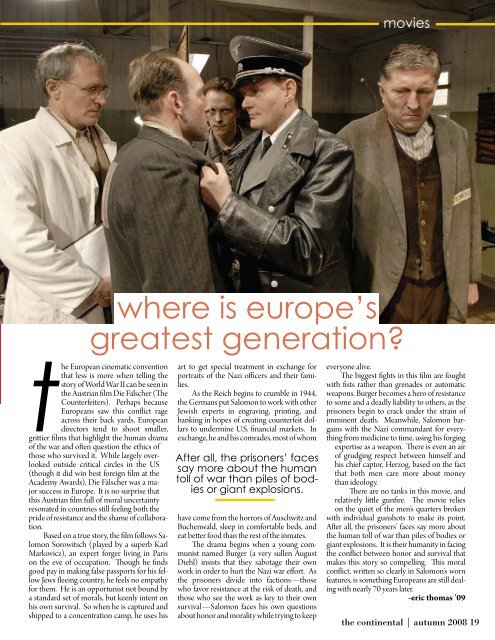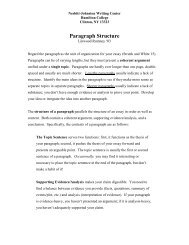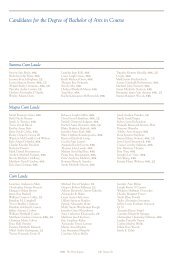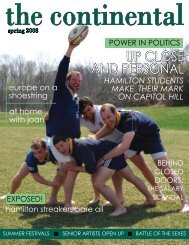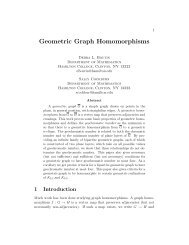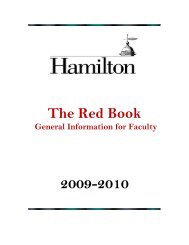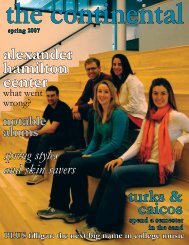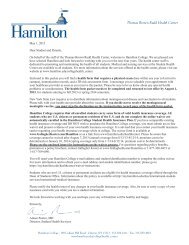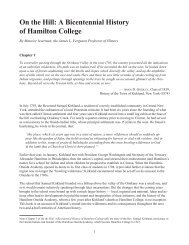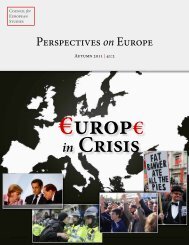UNCOVERING UTICA'S GEMS - Clinton - Hamilton College
UNCOVERING UTICA'S GEMS - Clinton - Hamilton College
UNCOVERING UTICA'S GEMS - Clinton - Hamilton College
Create successful ePaper yourself
Turn your PDF publications into a flip-book with our unique Google optimized e-Paper software.
talk movies of the town<br />
where is europe’s<br />
greatest generation<br />
the European cinematic convention<br />
that less is more when telling the<br />
story of World War II can be seen in<br />
the Austrian film Die Fälscher (The<br />
Counterfeiters). Perhaps because<br />
Europeans saw this conflict rage<br />
across their back yards, European<br />
directors tend to shoot smaller,<br />
grittier films that highlight the human drama<br />
of the war and often question the ethics of<br />
those who survived it. While largely overlooked<br />
outside critical circles in the US<br />
(though it did win best foreign film at the<br />
Academy Awards), Die Fälscher was a major<br />
success in Europe. It is no surprise that<br />
this Austrian film full of moral uncertainty<br />
resonated in countries still feeling both the<br />
pride of resistance and the shame of collaboration.<br />
Based on a true story, the film follows Salomon<br />
Sorowitsch (played by a superb Karl<br />
Markovicz), an expert forger living in Paris<br />
on the eve of occupation. Though he finds<br />
good pay in making false passports for his fellow<br />
Jews fleeing country, he feels no empathy<br />
for them. He is an opportunist not bound by<br />
a standard set of morals, but keenly intent on<br />
his own survival. So when he is captured and<br />
shipped to a concentration camp, he uses his<br />
art to get special treatment in exchange for<br />
portraits of the Nazi officers and their families.<br />
As the Reich begins to crumble in 1944,<br />
the Germans put Salomon to work with other<br />
Jewish experts in engraving, printing, and<br />
banking in hopes of creating counterfeit dollars<br />
to undermine U.S. financial markets. In<br />
exchange, he and his comrades, most of whom<br />
After all, the prisoners’ faces<br />
say more about the human<br />
toll of war than piles of bodies<br />
or giant explosions.<br />
have come from the horrors of Auschwitz and<br />
Buchenwald, sleep in comfortable beds, and<br />
eat better food than the rest of the inmates.<br />
The drama begins when a young communist<br />
named Burger (a very sullen August<br />
Diehl) insists that they sabotage their own<br />
work in order to hurt the Nazi war effort. As<br />
the prisoners divide into factions—those<br />
who favor resistance at the risk of death, and<br />
those who see the work as key to their own<br />
survival—Salomon faces his own questions<br />
about honor and morality while trying to keep<br />
everyone alive.<br />
The biggest fights in this film are fought<br />
with fists rather than grenades or automatic<br />
weapons. Burger becomes a hero of resistance<br />
to some and a deadly liability to others, as the<br />
prisoners begin to crack under the strain of<br />
imminent death. Meanwhile, Salomon bargains<br />
with the Nazi commandant for everything<br />
from medicine to time, using his forging<br />
expertise as a weapon. There is even an air<br />
of grudging respect between himself and<br />
his chief captor, Herzog, based on the fact<br />
that both men care more about money<br />
than ideology.<br />
There are no tanks in this movie, and<br />
relatively little gunfire. The movie relies<br />
on the quiet of the men’s quarters broken<br />
with individual gunshots to make its point.<br />
After all, the prisoners’ faces say more about<br />
the human toll of war than piles of bodies or<br />
giant explosions. It is their humanity in facing<br />
the conflict between honor and survival that<br />
makes this story so compelling. This moral<br />
conflict, written so clearly in Salomon’s worn<br />
features, is something Europeans are still dealing<br />
with nearly 70 years later.<br />
-eric thomas ’09<br />
the continental | autumn 2008 19


